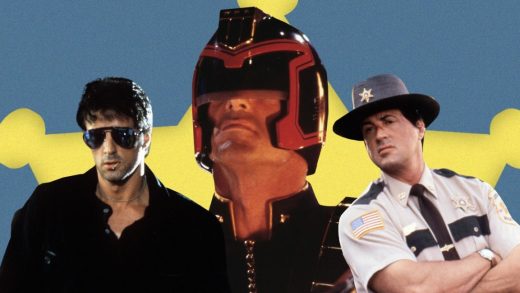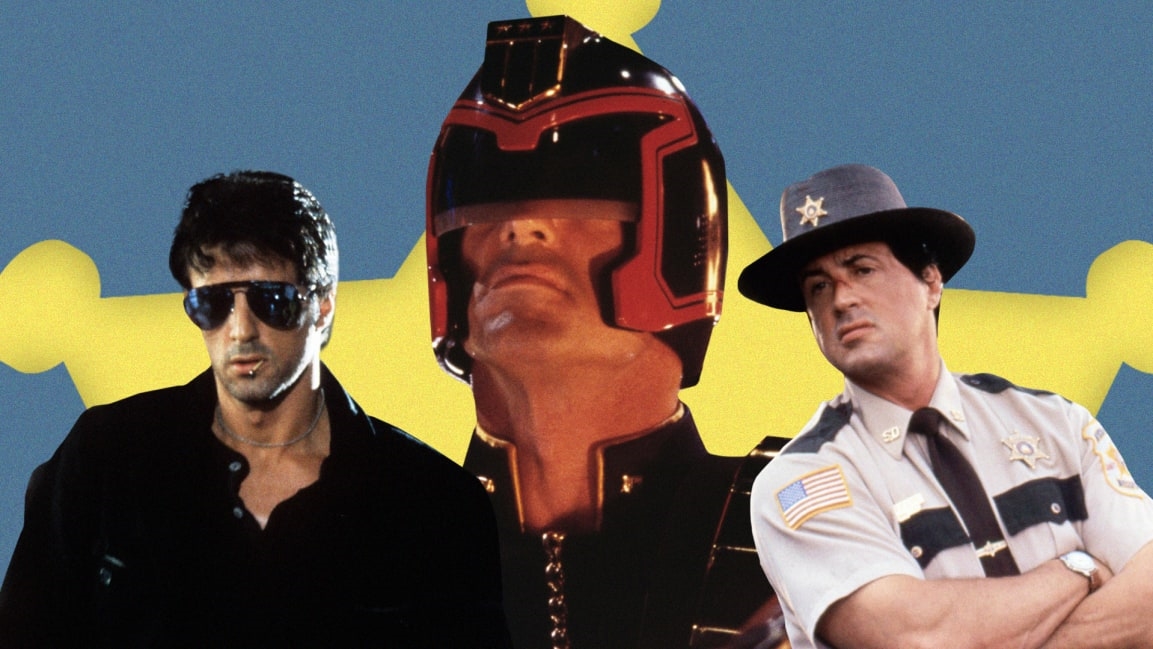How Sylvester Stallone cop movies explain changing attitudes about the police
“Please, don’t be too nice.”
That’s what TV star-turned-president Donald Trump told an all-cop audience in 2017 about how to handle suspects during an arrest.
But those police officers didn’t need to be told as much. They’ve been assured their entire lives by pop culture that good cops roughing up bad guys is what gets results. Only in our current apex Black Lives Matter moment, as countless videos reveal what it actually looks like when good cops behave not-nice toward supposed bad guys, is a critical mass beginning to question just what they’ve been rooting for in movies and TV shows—and what harm may have come of it.
A lot of this conversation revolves around television, where crime shows dominate a list of the top 100 most-watched series in 2019.
But movies have also reflected and helped shape America’s views on cops in a major way. During the 1980s and ’90s, Sylvester Stallone reigned supreme as our most prolific police-portrayer, and the arc of his cinematic message on law enforcement shows how American views on the topic can evolve—and still fall short.
The type before the prototype
Considering that Stallone’s signature roles are a Vietnam vet and a boxer, it may be surprising how often he’s played improbably noun-named cops like Ray Tango and John Spartan over the years. Starting with appearances in the TV shows Police Story and Kojak in the mid-’70s, Stallone has acted as a cop a dozen times in his career.
Incredibly, some of his earliest roles went in the opposite direction. He gravitated toward the kind of anti-authoritarian parts that might get the actor put on a secret antifa watchlist today. He played an anti-war agitator taking direct action in 1973’s No Place to Hide, and a union leader who starts a riot in 1978’s F.I.S.T. Years later, antiwar activists at Harvard would protest Stallone during a campus visit for his portrayal of John Rambo, but in 1982’s First Blood, the character took on corrupt police in a small town.
But just as Rambo went from a crafty near-pacifist in First Blood to a machine gun-wielding, rocket-launching angel of death in its 1985 sequel, Stallone quickly changed his tone. The police in his films went from fascist figures who should be eyed with suspicion to gritty heroes like conservative street cop Deke DaSilva, whom he played in 1981’s Nighthawks. Eventually, the filmmaker attempted to do for cops with his film Cobra what he’d done for soldiers and boxers: give them a mononymed, aspirational, badass mascot.
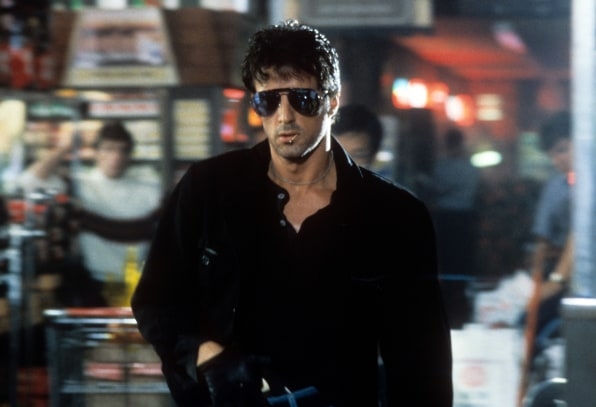
“You’re the disease and I’m the cure”
Cobra is a relic of its era, the mid-1980s, that now plays like parody. It’s cinematic Glamour Shots for cops. Stallone’s detective Marion Cobretti works out of the vaguely defined “zombie squad,” keeps a matchstick in his mouth, weathers leather gloves at all times, and drives around in a 1950 Mercury with a license plate that reads “Awsum 50,” as he looks for suspects to rough up.
It’s as if a Make-a-Wish kid got the chance to bring his idea of a rockin’ supercop to the big screen. (In reality, Stallone wrote the script himself.)
When we first meet Cobra, he’s taking down a grocery store perp, who mostly shoots at produce displays. “You’re a disease and I’m the cure,” he tells the evildoer, before flinging a knife in his chest and also shooting him a bunch of times. Believe it or not, this is what’s known in screenwriting terms as saving the cat—the minor good deed that puts viewers on the protagonist’s side early on. Since we’ve now seen Cobra use justifiable force to thwart an unfocused grocery store hijacker, we’re on board with whatever else it takes for him to cure the disease of rampant crime.
Some people are not so on board, however. When Cobra leaves the grocery store, he is immediately mobbed by top brass and nosy members of the media, who demand accountability.
“Did he have to die?” one crime-loving reporter asks, in a nasal whine. “Did you use unnecessary deadly force? What makes a policeman a judge and a jury? People have rights.”
Cobra is incensed that the media and pencil pushers won’t get out of the way and let him be great. He grabs the reporter by the shirt collar and forces him to look at the corpse of the grocery store shooter’s lone casualty on a nearby gurney. It has the intended effect.
Score one for Cobra. Ask any questions of his future actions and you too must love crime.
Cobra’s methods are unorthodox, a trait that is often praised and encouraged in movies going back at least as far as Dirty Harry, to which this movie is indebted and shares several actors with. But what if unorthodox methods aren’t actually that great? Every time Cobra uses lethal force in the film, it’s to protect an endangered supermodel (Brigitte Nielsen), but it’s the small, quiet moments that give away the game. During a montage of clue-gathering, Cobra grabs a guy in a bar by the shirt and violently yanks him closer. We never find out what this man—one of a handful of Black people glimpsed in the film—has done, we’re just to assume this is how you get information on the hard streets—and that it rules. Even more egregious, Cobra also uses Awsum 50 to push another car full of Latinos out of a parking spot. We don’t know whether this is Cobra’s designated space or not; it seems like an overreaction either way. When the other driver complains, Cobra slides his hand across the guy’s mouth, erotically dislodging a lit joint, and then rips the guy’s shirt in half like Hulk Hogan.
It’s just supposed to be a cool thing Cobra does, suavely asserting dominance. What it actually reveals is that Cobra (and Stallone) think cops should be above the law and beyond reproach at all times, so long as they get results—and that everyone else should stay out of their way. It’s a by-product of the worldview that everyone is unfairly mean to the cops who only want to protect them, a worldview the movie assumes all of its viewers share.
“There’s all these crazy people everywhere,” Brigitte Nielsen says late in the movie. “Why can’t the police just put them away and keep them away?”
“Tell it to the judge,” is Cobra’s response.
“What do you mean?” she asks, understandably.
“We put them away,” he says. “They let them out.”
At the time, violent crime was on the rise in the United States, nearly quadrupling between 1960 and its peak in 1991. Since recidivism among federal offenders actually declined in the previous decade, Stallone’s ire for overly lenient judges seems, well, unjustified. Less than a decade after Cobra, though—as violent crime finally began to decrease—Stallone would star in a movie that fixed the earlier film’s major beef with the judicial system.
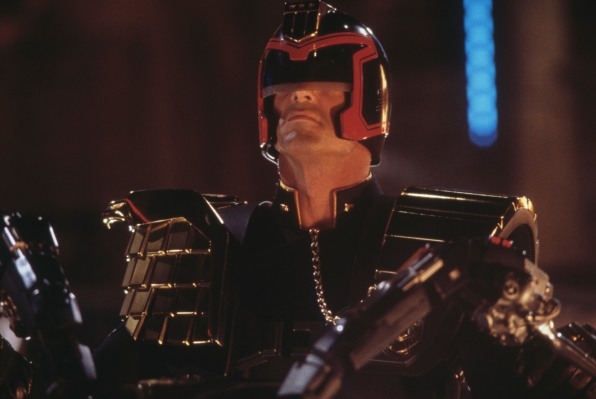
“I am the law”
Judge Dredd, in his original conception, is a stinging rebuke to movies like Cobra, and the U.S. police state in general.
The character first appeared in 1977, in the second issue of British sci-fi anthology 2000 A.D., as social commentary about the Nixon-era obsession with law and order. Dredd is an ultra-tough street cop, like Cobra, except he exists in a dystopian future where authoritarianism is the new democracy, and he has the triple-threat powers of judge, jury, and executioner.
It’s dark, funny, acid-laced satire.
The 1995 Stallone movie, Judge Dredd, however, field strips the conceit of its barbed critique and plays things shockingly straight.
“It deals with a political ideology that may not sit well with people,” Stallone said of the film in an interview at the time.
The movie doesn’t seem to feel one way or another about its political ideology, though, so it’s hard to imagine audiences getting too worked up about it either.
Pitched between a cartoonish summer blockbuster and a hyperviolent, hard-R shoot-’em-up, Judge Dredd makes the fascism go down smooth. It becomes clear that the all-in-one judge-cop system is flawed, not when Dredd kills his first several perps, but when he convicts a newly released nonviolent offender (Rob Schneider) for illegally hiding in a robot trashcan during the crossfire. This injustice is meant to bum viewers out, but not for very long. When Judge Dredd explodes a traffic violator’s car a few scenes later, on the charge of third-degree sass mouth, more or less, it’s played for laughs.
“I am the law,” is one of Dredd’s several catchphrases, and it doesn’t really seem up for debate.
Only when Dredd himself is wrongfully convicted of a crime does the character begin to see the inherent flaws of a system where every cop is literal judge, jury, and executioner. But he isn’t moved by these flaws so much that he changes anything beyond clearing his own name and saving the day. The contradictions aren’t explored in any meaningful way. All the innocent people he’s likely convicted in the past aren’t given an onscreen thought. This whole adventure just a bad thing that happened to Judge Dredd in the opening salvo of a hoped-for franchise. (The film ended up performing so poorly that Stallone called it “the greatest mistake I ever made” on a press tour in 2008.)
One of the more telling moments of Judge Dredd, though, as in Cobra, is one of the more quiet ones. Dredd is able to convince a senior judge (Max von Sydow) of his innocence without any exculpatory evidence, by mere denial.
“I just needed to look into your eyes for myself,” the senior judge tells him. “Sorry to ask.”
Even in this hardcore fascist future, the implicit trust between cops remains. It’s a subject that Stallone would explore in the next police movie he starred in, perhaps the least likely role of his entire 50-year career.
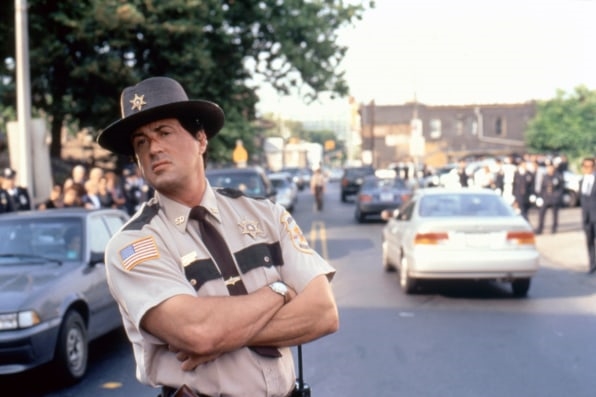
“He’s good people”
In a full-circle return to the wary worldview of First Blood, 1997’s Cop Land is a film about corruption in law enforcement. More importantly—and more relevant to 2020—it’s a film that allows no daylight between actively dirty killer cops and the otherwise decent ones who allow the rot to fester unabated.
“He’s good people,” Ray Liotta’s Detective Figgis says about Stallone’s sheriff Freddy Heflin near the beginning of the film.
What he means, ultimately, is that Heflin is a secret-keeper. An order-upholder. He won’t be any trouble.
Over the events of the movie, of course, Heflin develops a conscience and turns against the Harvey Keitel-led gang of corrupt cops, who all live in the same New Jersey community. Although it might be too generous to say he’s redeemed himself for the sins of his past by the end, he at least goes from being part of the problem to being part of the solution. In real life, police solidarity is so strong that 57 officers in Buffalo resigned over the charging of two officers who critically injured a 75-year-old protester last week.
It’s nice to imagine, however, that Heflin would go on to be one of those cops that quit recently to join the Black Lives Matter movement.
The good cop who snuffs out corruption within the force has a rich cinematic history, going back to Al Pacino in Serpico. Cop Land, however, has the added novelty of Stallone—Marion Cobretti, himself—playing against type as he cleans house. There’s a subtextual whiff of all of the actor’s past police roles co-signing this movie’s message.
Cop Land was clearly a passion project for Stallone. He worked for scale and gained almost 40 pounds for the role. The reason he was so pumped about the movie, however, is not because it’s a repudiation of his most oft-donned uniform. As he said in interviews at the time, he was mainly eager to work with a hot indie director, James Mangold, a stacked cast that includes Robert De Niro in addition to Liotta and Keitel, and in a movie that wasn’t Judge Dredd.
“I didn’t want to do ultra-violent, metronomic, mathematical films,” he told the Washington Post. “I wanted to do something that moves you.”
This desire didn’t take.
After reviving the Rambo franchise a decade later, Stallone went on to make three entries and counting in the Expendables series, some of the most violent, silly, and lucrative movies of his whole career.
The message of Cop Land didn’t seem to take either. Stallone has talked as recently as last year about rebooting Cobra.
Nobody should begrudge him this lapse, though.
Clearly the message of Cop Land didn’t stick with audiences, either.
(90)

